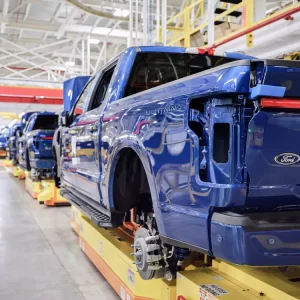Can an industrial renaissance make America stronger, greener and richer?
t its apogee in the 1930s Ford’s River Rouge complex, just outside Detroit, employed some 100,000 people and produced a car every 49 seconds. Diego Rivera, a Mexican artist, painted a series of murals depicting the heroic workers and futuristic machines, working in harmony to usher in a new era of prosperity.
Almost a century later River Rouge is getting a new lease on life. Construction workers are busily expanding the assembly lines that produce the f-150 Lightning, the electric version of America’s bestselling pickup. There is less clanging than when Rivera visited, and more whirring. Mechanical claws effortlessly whisk vehicle frames from place to place. Self-driving carts glide around the factory floor. Ford is hoping for a surge in sales thanks to lavish new tax credits for people who buy American-made electric vehicles. But it is not just the factory that is enjoying a renaissance: so is the dream that River Rouge once embodied, of an America made prosperous by multitudes of jobs in cutting-edge manufacturing.
Over the past two years, urged on by President Joe Biden, Democrats in Congress have enacted a series of laws to revive manufacturing in America, as part of a $2trn overhaul of the economy. The chips Act, passed in July, includes $39bn to spur domestic production of semiconductors, along with even bigger investments in research and development. The Inflation Reduction Act (ira), approved in August, boosts clean energy in many ways, including tax credits for manufacturing. The Congressional Budget Office estimates these will cost $37bn over a decade, although it could be much more, since the ira does not limit the total value of credits that can be claimed. There are indirect subsidies for manufacturers, too, in the form of tax credits for consumers who purchase American-made goods. Then there are a multitude of factory-friendly regulations, such as “Buy American” rules for government procurement. In 2021 Congress also approved $1.2trn in spending on infrastructure, intended in part to make American manufacturing more competitive.
The subsidies apply mainly to two industries: clean energy and semiconductors. The intention is not just to spur manufacturing, but also to curb climate change, limit dependence on China and pep up parts of America that have fallen behind. This ambitious agenda helps explain why the laws feature so many complicated and overlapping incentives.
Some take the form of tax credits tied to production volumes: $3 for every kilogram of green hydrogen, for example, or $35 for every kilowatt-hour of battery capacity. Solar panels, wind turbines and even certain minerals used in clean technology benefit from similar credits. There are tax credits for investments, as well, in manufacturing facilities producing gear used in all manner of clean-energy projects, from geothermal power to carbon capture and storage.
The same industries will also be boosted by plentiful indirect subsidies. Investment in low-carbon power-generation will enjoy bigger tax credits if the equipment involved is made in America. The same is true of the power generated by such facilities. By the same token, tax credits for consumers who buy electric cars can be claimed only if the cars in question are made in North America.
States are doling out handouts, too. Georgia recently provided over $3bn in financial incentives to two carmakers building electric-vehicle factories, in addition to other perks. Michigan, dismayed by Ford’s announcement in 2021 that it would build new factories in Kentucky and Tennessee, is mimicking southern states by assembling plots for manufacturers that might invest in the state, before specific companies have expressed interest. The idea is to help firms build factories as quickly as possible.
Pumps and accelerators
These elaborate efforts to foster certain industries already seem to be bearing fruit, despite a slowdown in manufacturing more broadly (a prominent index of manufacturing activity slid in January). Carmakers announced $68bn-worth of projects in 2021 and 2022—the industry’s biggest building boom in decades. Since Mr Biden became president, the White House points out proudly, manufacturers have announced some $290bn in investment.
Much of that investment was initiated before Congress approved the new subsidies. But since the ira became law, First Solar, a manufacturer of solar modules, has said it will expand production in Ohio and build a new factory in Alabama. In January Hanwha Qcells said it would spend $2.5bn to increase its output in Georgia by a factor of five.
Chipmakers have announced a similar surge of investment, with $200bn spread across 16 states. tsmc, a Taiwanese firm, is building a new factory in Arizona, Intel one in Ohio and Micron one in New York. Smaller firms that supply these chipmakers are also making big plans. Tom Stringer of bdo, which advises manufacturers about where to build new factories, is assisting several dozen chip suppliers scouting for good locations.
All told the ira may spur $1.7trn in public and private investment, reckons Credit Suisse, a bank. The spending unleashed by it, the chips Act and the infrastructure bill are “among the most significant investments that we’ve ever made”, Janet Yellen, the treasury secretary, declared last year. On a visit to tsmc’s new factory in Arizona in December, Mr Biden exulted, “We’re making things here in America and shipping the products overseas rather than shipping the jobs overseas to make things overseas and bring them back home.”………….
